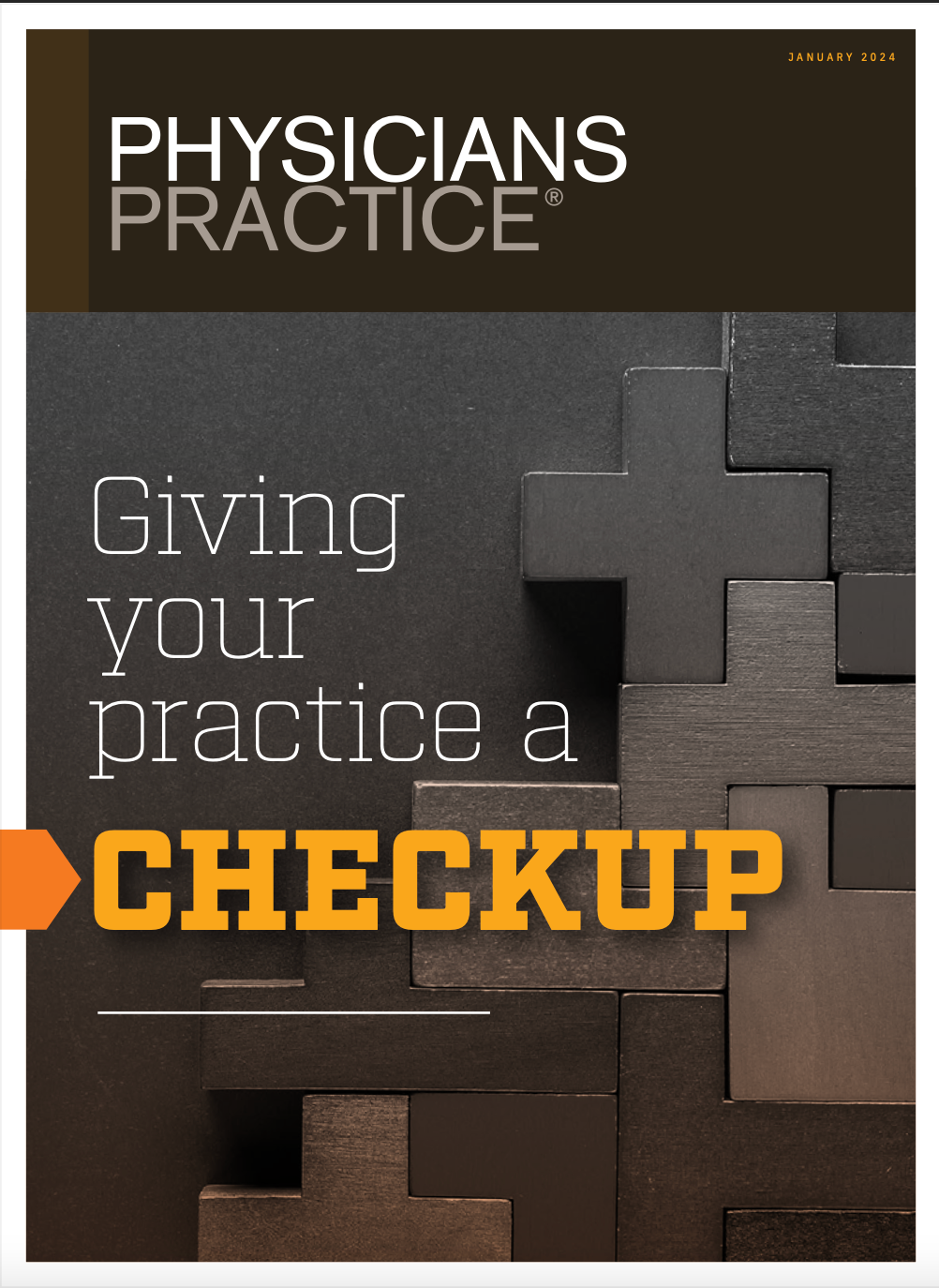Giving your practice a checkup: Generating new patients using social media
The importance of social media to your practice's growth.
© Art_Photo - stock.adobe.com

With this blog, I illustrate the value of having a social media presence and how to use social media to attract new patients. I used social media to promote my medical practice for 5 years. I can be found on the first page of Google search results for several medical conditions I treat and manage. As a result of these high search rankings, I have added two to four new patient visits every day.
You can achieve the same results using the techniques described in this blog. You certainly can buy banner ads and create traffic to your page, but I want to show you how to get on the first page of Google using the natural, organic method.
Push vs. pull marketing
There are two ways to share your information on the Internet:
- Push occurs when you initiate the process by placing your information before the Web site surfer. They get it or see it because of the actions you have taken. Sending e-mails is one way to push information to your target audience, or potential patients, to your practice. Another way to push your website and its contents is to get listed on the first page of search engine results, i.e., Google, Bing, and DuckDuckGo. You want to "push" your Web site in plain view of the person who has typed in keywords or keyword phrases that relate to your practice (i.e., "gynecologist" plus "<your city>," "tubal ligation" plus "<your city>," or "loss of urine" plus "<your zip code>." Push techniques are the best way to market your services and offer the best return on your marketing investment.
- Using social media, you can "pull" your audience of potential patients to your practice. In other words, your target market of potential patients has to type in your website address to come to you. The information or message you have on your social media sites must be strong enough and of sufficient compelling interest that patients want to come to read what you have to say. Web surfers are looking for online relationships for information sharing. It is this interaction with your potential patients that makes social media unique. Using this pull technology, you can interact and develop a relationship with a patient before they pick up the phone to make an appointment before they come to the office to see you in your brick-and-mortar facility.
Facebook and how it relates to your practice
Initially, Facebook was developed as a way for people to see what was going on in each other's lives and a method to stay in contact with one another. Initially, it was friends, family members, or groups of like-minded individuals frequenting each other's Facebook pages.
Facebook has evolved. Today, companies, businesses, and, yes, medical practices are trying to "pull" more Web site visitors to their Facebook pages. Large companies and large group practices like the Mayo Clinic, Cleveland Clinic, and MD Anderson Cancer Center have whole social media departments that post regularly, respond to comments left on their pages, and answer questions posted by those who "like" their page or site.
Individual practicing clinicians and most smaller practices need more money for a social media team. They also don't have the time or the training to write effective copy that is so compelling that Web surfers are drawn or "pulled" to their Facebook page. However, your patients expect you to have a Facebook page, and they expect you to have quality information that is helpful and relevant to their well-being.
Can Facebook generate new patients? You can place a lot of information and pictures on Facebook; potential patients can leave comments or ask questions easily. You can start a dialog with a patient without medical advice and motivate her to see that you provide medical value before establishing the doctor–patient relationship. A Facebook page can generate new patients if the information you post is current, credible, and informative.
For instance, your practice is probably restricted to a few zip codes surrounding your office and hospital— which means you only want patients in your area to visit your practice's Facebook page because those are the only ones likely to call and make an appointment. Unless you are highly specialized in a particular field, the Facebook surfer from New York isn't expected to come to your practice on the West Coast for medical care.
Competing with larger practices and hospitals with more dedicated staff to draw prospective patients to practice through Facebook appears difficult or impossible. However, the real, overarching challenge is to improve your website rankings on the major search engines, to be on the first page of Google, Bing, and Yahoo search results. And what we do know is that Google has placed a high value on Web site rankings through social media sites like Facebook, Twitter, and YouTube—that is, of course, if your Facebook page provides content that has keywords relevant to your target market and the content on your page links back to your website.
You will get more visitors to your website if it is found on the first page of search engine results because of your Facebook posts. Your website must be set up correctly for easy navigation and visitor conversion. In that case, you may need help to obtain the desired result of gaining new patients. You need a website with marketing and patient conversion systems built into it.
YouTube videos
YouTube has become a significant search engine for every product and service you offer. There are millions of videos on YouTube, and viewers can search for topics simply by typing in any medical topic.
There are five ways your practice can benefit from a video posted on YouTube:
- Website traffic driver. To achieve this "pull," you must label your posted video correctly, with keyword phrases relevant to the type of patient or conditions they are looking for, and offer a description that would make a viewer want to see the video. You must provide a link to your Web site, increasing your chances of gaining a new patient.
- Boost your search engine optimization. Google places a high-ranking factor on videos posted to YouTube that are keyword-relevant.
- A video library can position you as an expert. You can create your own YouTube channel and keep adding videos. I have posted more than 70 medical videos on YouTube. If someone views one of these videos, they will have immediate access to the rest of the video collection, even though they may be labeled with other keywords. This positions you as a knowledgeable expert in your field.
- Video embedding capability. Any video posted to YouTube can be placed on your website in a format that keeps the viewer on your site. This means the viewer has less chance of getting distracted by other video offerings and landing on someone else's website.
- Free video storage. Because you have stored the video on YouTube, you are not using the resources on your website when someone or several people view the video simultaneously.
Getting started with YouTube
A video can be a PowerPoint presentation. Studies have demonstrated that it is more about the content of the video than a physician being in front of a camera. You can use many websites to record a presentation; one of the most popular and easy to use is Zoom.com.
You can select a few frequently asked questions (FAQs) that your patients regularly ask and record providing the answers. Look at what is new, relevant, or controversial regarding the procedures you perform or new medications you prescribe. The ideal video length is 3 to 5 minutes in length. It is my experience that it is hard to hold a viewer's attention for more than five minutes.
Using Twitter (now X) to attract new patients
The most amazing example of social media and building a fan base is Twitter. Here's a question: Who are the people with the most extensive Twitter following? The answer: celebrities, rock stars, and athletes. As a society, we are obsessed with these groups and want to know their every thought, what they like, what they had for lunch.
How do you expect to build a base of website surfers who want to know your every thought on a medical condition? The harsh reality is if you think you will get new patients by making posts on Twitter of 140 characters or less every day, you will be disappointed.
Twitter is one of the top-accessed Websites in the world. Linking your own content from such a website increases the connection to your practice of content when a potential patient performs a general Google search.
Use of TikTok
TikTok, a social media platform known for its short-form video content, has found an unexpected but valuable niche in the healthcare industry. Healthcare professionals and organizations increasingly use TikTok to educate, engage, and connect with patients and the wider public.
One of the most significant advantages of TikTok in healthcare is its ability to simplify complex medical information. Doctors, nurses, and health educators create informative and entertaining videos on topics ranging from basic first aid to mental health advice. These videos educate and break down barriers, making healthcare information more accessible.
TikTok has an impressive user base, especially among younger demographics, making it a potent platform for healthcare professionals to disseminate information and engage in meaningful conversations about health-related issues. TikTok is about having fun, being creative, and connecting with potential patients.
Is social media effective?
The effective use of social media can attract new patients daily to your practice. Regularly posting quality information is helpful to your existing patients and especially potential new patients. Social media can help you get new patients through search engine rankings. Even if you want to avoid doing any work on your social media sites, you can hire companies that will do it for you. Suppose you decide to outsource your social media efforts. In that case, I recommend that you work with a company with medical social media experience.
The Bottom Line
Today's patients are technologically sophisticated, and these social media techniques will continue to evolve. Stay caught up. And keep your competitors from dominating one of the most important sources of new patients you have, along with patient and physician referrals. Jump into this world of social media, and you will be richly rewarded. The social media train is leaving the station, and I hope I have shown you how to hitch a ride. See you online!
Neil Baum, MD, a Professor of Clinical Urology at Tulane University in New Orleans, LA. Dr. Baum is the author of several books, including the best-selling book, Marketing Your Medical Practice-Ethically, Effectively, and Economically, which has sold over 225,000 copies and has been translated into Spanish.
Newsletter
Optimize your practice with the Physicians Practice newsletter, offering management pearls, leadership tips, and business strategies tailored for practice administrators and physicians of any specialty.
2 Commerce Drive
Cranbury, NJ 08512
All rights reserved.
